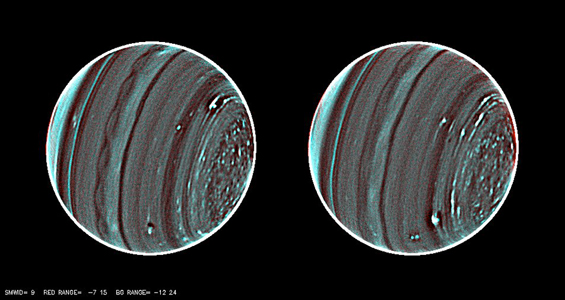SSEC Scientists Produce Highest Resolution Image of Uranus
On 24 and 25 July 2012, SSEC planetary scientists Larry Sromovsky and Pat Fry, along with co-investigators Heidi Hammel (Space Science Institute, Boulder, CO) and Imke de Pater (UC Berkeley), captured unprecedented views of the planet Uranus.
The team used one of the two Keck Observatory telescopes situated at the summit of Mauna Kea, a 14,000 foot extinct volcano on the Big Island of Hawaii. The ten-meter telescope is effectively the largest telescope in the world and, using the near infrared camera (NIRC2), the team achieved amazing results.
“We were fortunate to have good weather, good viewing, and excellent equipment performance both nights,” Principal Investigator Larry Sromovsky said. “Our object was to achieve a very high signal-to-noise ratio so that we could see very subtle cloud features.”
Uranus, about 3 billion miles from the sun, is unusual in that it has an axial tilt of 97.77 degrees. At its solstice Uranus’ pole faces the sun continuously, while the other pole faces away. Given the planet’s 84-year orbital cycle, each pole is constantly lit by the sun for 42 years and then plunges into 42 years of uninterrupted darkness. Following the last equinox on 07 December 2007, the north polar region has been emerging from its long night, providing improved views of its peculiar cloud structure.
The team’s preliminary results are shown in the image pair below. Each image was obtained by averaging over 100 images, after remapping to latitude-longitude (to remove rotational smear), then reprojecting on a planetary disk. Finally a high-pass filter was used to enhance the small-scale variations, while suppressing the large variations with latitude.
“These are the most richly detailed views of Uranus yet obtained by any instrument or any observatory.” Sromovsky says. “No other telescope, including the Hubble Space Telescope, could come close to producing this result.”
Among many unusual features seen in this pair of images are the numerous small bright spots in the north polar region (the right hand portion of images), which are similar to what is seen in both polar regions on Saturn, but are only present in the north polar region of Uranus. The difference in polar formations may be due to seasonal asymmetries in cloud motions.
The transverse dark wave scallops (just south of the equator) have never been seen before. The bright waves of cloud brightness just north of the equator, and the small dark spot with bright companions near the bottom of the left hand image, also present new areas for study.
Following the 2007 equinox, when the planet’s rotation was most visible from Earth, new circulation measurements were gathered from observations by the Hubble Space Telescope, and by the Gemini North telescope (an 8.8-meter telescope also located on Mauna Kea). With the addition of these Keck images, new measurements of winds over previously sampled latitudes as well as at high northern latitudes are more accurate. These new images reveal a transition from streaky bands of clouds below 60 degrees north, to an area of widely distributed small bright spots which resemble cumulus cloud fields toward the north pole.
“Since 2007, the north polar region of Uranus has become much better exposed,” Sromovsky says. “This gives us a better chance to determine wind profiles in the northern hemisphere, the different styles of discrete styles of cloud features there, and the altitudes of many of these features.”

